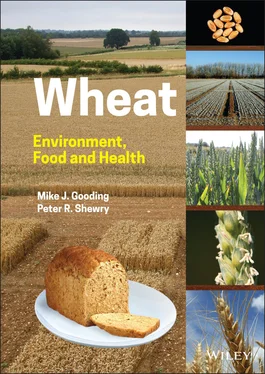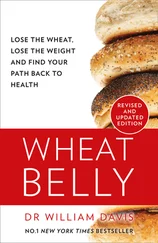1 ...7 8 9 11 12 13 ...21 Harvest can proceed once grain moisture content drops below 18–20% but at this level further drying before or during storage will be necessary. In the UK, the target moisture content for safe temporary storage at ambient conditions going into autumn after harvest is 14.5% or below (AHDB 2011). The equivalent for Australia, with its warmer conditions, is 12%, and grain loads with higher than 12.5% moisture are prevented from entering the marketing system (Newman 2008). In Canada, wheat is graded as Straight , Tough , and Damp for moisture contents of < 14.6, 14.6–17.0, and > 17% respectively (CGC 2020). In the US moisture does not affect wheat grading, but the price of wheat will depend on contract specifications: various discounts can be applied as moisture contents rise above 12% (Wilson and Dahl 2002).
1.3 Wheat Evolution and Migration
1.3.1 Origin in the Fertile Crescent
Wheat was first used, domesticated, and farmed in and around what has become known as the Fertile Crescent. This term was first coined by J.H. Breasted (1916), when he described an area covering a narrow arc from the southeast corner of the Mediterranean Sea to the northern tip of the Persian Gulf ( Figure 1.14). For him, the Fertile Crescent comprised hilly flanks limited by mountains to the north and east, by plains and a drying desert to the south, and by the sea to the west. The Fertile Crescent has been redrawn many times since Breasted (1916), reflecting new archaeological discoveries and the expansion of agriculture from its origins. Hence, over time the area scholars referred to as the Fertile Crescent became broader and extended down to include more of Mesopotamia between the Tigris and Euphrates rivers, and the Nile delta of Egypt. As well as wheat, other plants used and domesticated in the Fertile Crescent included barley, lentil ( Len culinaris ), pea ( Pisum sativum ), chickpea ( Cicer arietinum ), broad bean ( Vicia faba ), and flax ( Linum usitatissimum ). Rye and oats ( Avena spp.) may well initially have been identified by early farmers as weeds in their wheat fields; later they became domesticated crop species, possibly as agriculture moved into cooler areas (Evans 1993; Kilian et al. 2009).
Although the climate of the Fertile Crescent has changed since the earliest cultivation, wild wheats persist in the area today. Notably, they still occur in regions where early farming settlements have been identified (Evans 1993; Nesbitt 2001). It seems likely, therefore, that early cultivated wheats were adapted to growing in the cooler and wetter winter and spring, maturing before the excessive heat and drought of summer.

Figure 1.14 The Fertile Crescent as originally described by J. H. Breasted.
Source: Redrawn from Breasted (1916).
Chromosome and genetic analysis have facilitated our understanding of the relationships between the wild wheats of prehistory and the cultivated wheats of today. All members of the Triticeae have multiples of a related set of seven chromosomes (genomes), numbered 1–7. Diploid (literally two‐fold likeness ) species have two copies of each chromosome (2x = 2n = 14). Some sets of chromosomes are more similar than others and they have thus been grouped accordingly. Those sets of chromosomes relevant to wheat evolution are labelled the A, B, D, G, and S genomes ( Figures 1.13and 1.15; Kihara 1929, 1954; Dewey 1984).
The diploid species carrying the different, but related, sets of chromosomes appear to have diverged between 2.5–4.5 MYA (Huang et al. 2002). Two species of wild diploid wheat (wild einkorn) are found today: Triticum uratu and Triticum monococcum var. boeoticum ( Figure 1.15). Both species have the genome formula AA, i.e. they have a diploid complement of the A set.
Although the diploid species are biologically isolated, hybrids have been formed in the Triticeae through allopolyploidy. This is a type of hybridization where the offspring inherit the complete chromosome complement from each of the parents. For example, wild emmer contains four sets of chromosomes, the diploid complement from T. uratu (AA) and the diploid (BB) complement from a type of goat grass ( Aegilops spp.). Wild emmer ( Triticum turgidum var. dicoccoides ) is therefore an allotetraploid (4x = 28) with genome formula AABB. This allopolyploidy is made possible because the different sets of chromosomes from the diploid species do not pair during meiosis in the polyploids ( Chapter 10). Such sets of chromosomes, which are homologous but non‐pairing, are termed homoeologous (Glover et al. 2016), for example, chromosomes 1A and 1B in emmer are homoeologues.

Figure 1.15 Summary of the genome constitutions and evolutionary relationships of the major wild and cultivated forms of wheat ( Triticum spp.).
The hybridization to produce wild emmer occurred naturally, possibly between 0.2 and 0.5 MYA (Huang et al. 2002; Gill et al. 2004). A second wild tetraploid species also occurs ( Triticum timopheevi var. araraticum ) with the genome formula AAGG. Although the B and G genomes are distinct, they are known to be related and both may be derived from the S genome present in the Sitopsis section of Aegilops , with Ae . speltoides being the closest currently existing species. The two tetraploid wheat species may, therefore, have diverged after the formation of an ancestral AASS tetraploid. In fact, Dvořák et al. (2006) considered that the B, G, and S genomes are sufficiently alike to be classed as the same group.
Genetic changes occurred as gatherers and early farmers selected traits in the wild diploid and tetraploid species that facilitated their cultivation, giving rise to distinct cultivated forms that are regarded here as variety groups (var.). Variety groups within the Triticum species are sometimes referred to as subspecies (subsp.) in other classification systems. The cultivated forms of wheat have traits collectively known as the domestication syndrome . Two traits have been particularly important in the domestication of wheat. The first is the loss of shattering of the spike at maturity through having a semi‐tough rachis . It is important for the rachis of mature ears of wild plants to be brittle, such that the ear shatters or disarticulates to aid seed dispersal. By contrast, mutations at the Br (brittle rachis) loci on the short arms of group 3 chromosomes (Nalam et al. 2006) confer a semi‐tough rachis that keeps the ear intact. This prevents seed loss before manual harvesting; although this is highly advantageous to gatherers and farmers, it represents a significant loss of fitness for the wild plant. The appearance of the non‐shattering phenotype in the archaeological record is, therefore, often assumed to be confirmation of wheat cultivation (Allaby et al. 2017). However, it is also likely that cultivation of wild types predated that of domesticated forms. Both shattering and non‐shattering forms are found within the Fertile Crescent dated to the same time, and often within the same site (Tanno and Willcox 2012). There are very early dates for the first possible appearance of non‐shattering einkorn (> 11 000 BP) and emmer (> 10 000 BP), at camps or settlements where shattering types dominated (Allaby et al. 2017). Thereafter the shift from non‐shattering to shattering forms was a slow evolutionary process. The greatest selection pressures from the presumed adoption of cultivation are estimated to be from 10 500 to 9500 BP (Allaby et al. 2017), but the complete transition to domesticated forms probably took three to four millennia (Fuller et al. 2012). Today, all cultivated forms of wheat have a semi‐tough rachis.
Читать дальше














